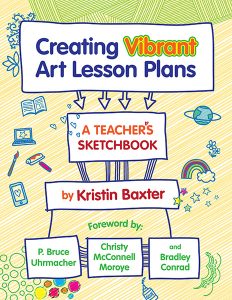By Kristin Baxter
Yes. It is possible! Writing art education lessons plans (or any lesson plan, for that matter) can seem like a tedious chore completed by a teacher for use by someone else (maybe) other than the teacher! However, I’d like to invite you to consider writing art lesson plans for a moment as a way to nurture your creative souls, which I lovingly refer to here as “unicorns and rainbows.” In my forthcoming book, Creating Vibrant Art Lesson Plans: A Teacher’s Sketchbook, I present the architecture of the many possible sections that could be used in an art education lesson plan. I go on to suggest that we can use the writing of art lesson plans as a method of self-reflection on what really matters to us as art teachers, artists, and creative souls.
 Make a list
Make a list
One of the first steps in writing an art unit and the individual lessons within that unit, is to get to know our students, communities, and ourselves! What do you love most about the community in which you teach? Make a list! If you had out-of-town visitors for the weekend, what sightseeing trips would you plan right in your own neighborhood or town? Plan a day trip to those sites and be a tourist! Or, make a list of your favorite movies, books, and tv series, or ones you keep meaning to get to. The next time you’re teaching, start a list of things you overhear your students talking about. What type of clothing, music, shoes, hair accessories, etc. are important to them? What books are they reading in other classes? Make lists!
Find out what makes your heart sing
Consider visiting those places on your list of sightseeing destinations. Then collect found objects, brochures, ticket stubs, and photos. Back at home, look at those objects and images and see if there are interesting shapes, textures, and colors. What do the objects and images say about the community and its history? Take a look at those movies, books, and tv shows that interest you. What’s compelling about them? Start Pinterest boards with the interests of your students. What are really interesting “Big Ideas” that seem to float to the surface as you look at what you’ve collected? How might you use these experiences, images, and objects as the generator of ideas for lesson plans for your students or for your own personal body of artwork?
Take time out for self-care
Throughout my 25+ years of teaching art to children and adults, in various settings such as in schools, colleges, universities, museums, galleries, community centers, and now in a county-run juvenile justice center, I’ve had the privilege of meeting so many people. We meet at different points in life’s journey but the one thing we have in common, is that we can all benefit from taking time out to acknowledge that life is (really) hard sometimes. [Queue the deep breath]. Is there a way to reframe the preparation that we do for our art lessons so that the process feels nurturing to our professional and personal souls? Find out what is meaningful to you. For some, self-care might simply be a walk with your dog, a massage, or a nap. For others, self-care might look more like a trip to the library or museum – alone – to get lost in one’s own line of thinking for a while without all the chatter and distractions that we encounter in daily life. Whatever feels right for you. Do it. These moments of self-care can bring you back to what’s really meaningful to you about creating and teaching art.
Together, these three ideas embody what I mean by finding the “unicorns and rainbows” in our art lesson plans. Rather than seeing our lesson plans as simply a bureaucratic obligation to check off our to do list, could we find glimpses in there of what’s really magical about the world? If writing is a way of thinking and a way of processing our life experiences, then let’s use our art lesson plans as a way to construct new knowledge of the world and of ourselves. That’s how we’ll find our own personal unicorns and rainbows.
Featured Image: Children’s art classroom, public domain via Pixabay
Kristin Baxter is associate professor of art and director of the Art Education Program at Moravian College in Bethlehem, Pennsylvania.
